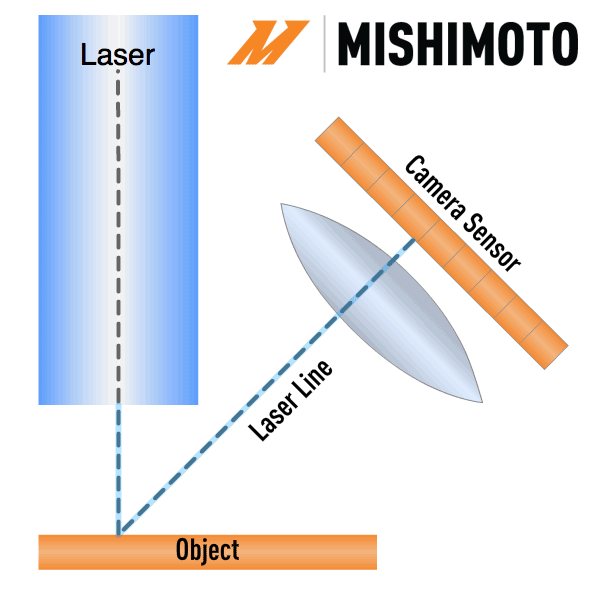
Scanning Our Horizons: FARO Design ScanArm - 3D Scanner
Here at Mishimoto, we're all about speed and quality. Our mission is to provide you with high-quality parts to make your cars better, and we love finding new ways to make those parts and get them to you faster. Our newest companion in this mission is our FARO Design ScanArm. FARO is a Florida-based company that specializes in 3D measurement technology. FARO's products are used by leading corporations across numerous industries, from Aston Martin and BMW to NASA, so we're definitely in good company here at Mishimoto. The FARO Design ScanArm uses a laser, along with an integrated camera system, to map the surface of almost any object. So how does this help us make parts better and get them to you faster? First, let's take a look at how the system works.
Freakin' Laser Beams
The FARO Design ScanArm works by shining a laser stripe on the surface to be scanned. An integrated camera then records the position of that laser at various points along the stripe. The ScanArm records this information 280 times per second and at 2,000 points along the laser stripe, giving us 560,000 points of information per second to work with. Apparently, Dr. Evil just wanted a bunch of sharks with the ability to accurately scan surfaces and make awesome car parts. In order to map the surface of the object being scanned, the ScanArm must determine the distance of the camera from the surface. This process is called triangulation, and to explain how it works, we have to go back to high school trigonometry class (don't worry, I failed trig, so we'll keep it simple).

The FARO Design ScanArm's camera (leftmost opening) and laser emitter (rightmost opening)
Basic trigonometry states that, in order to find the length of one side of a triangle, you must know at least one angle of the triangle and the length of another side. In the case of the ScanArm, the system knows the length of one side and two angles of the triangle. Because they are fixed to each other, the ScanArm knows the distance between the laser's origin and the camera, thus completing one side of the triangle.
The first angle is also built into the ScanArm as the angle of the camera in relation to the laser emitter. The second angle is a little trickier and takes some clever programming to figure out. As the distance between the ScanArm and the object being scanned changes, the angle at which the laser is reflected into the camera changes as well. This angle of reflection determines where in the camera's field of view the laser is recorded, and from this point, the ScanArm can determine the reflection angle of the laser. Finally, from these three variables, the ScanArm can do some math and determine how far away the object is from the camera at each point along the laser stripe, accurately mapping its surface in beautiful detail. Check out the diagram below for help visualizing this process.

This animation demonstrates how the ScanArm determines how far away the scanned surface is from the camera using triangulation
More Parts, More Faster
So how does all of this math help us to make prototypes and parts faster? It's pretty simple, really: the more time we spend tweaking a product in the digital world, the less time we have to spend making adjustments in the real world. The difference in time that it takes to make a change in the digital realm, compared to making the same change on a physical prototype, is exponential.
Take a catch can bracket, for example. If we were to cut a bracket on our water jet, test-fit it, and find that it needed to be shorter, that would require going into our design program to redraw the bracket, cutting it on the water jet again, and finally, test-fitting again. That process can take anywhere from an hour to days, depending on how many jobs need to be run on the water jet and how long it takes to draw and test-fit the piece.

The FARO Design ScanArm is revolutionizing the way we develop products.
By comparison, making the same change with the vehicle 3D-scanned requires only a few steps. Most of our products are constructed in 3D drawing software to begin with, and scanning an area of the car takes only a few minutes. To make a change and test fit a digital prototype, all the engineer would have to do is make the design change with a few clicks and apply the digital prototype onto the 3D model of the car. The Faro Design ScanArm is so accurate that we've been able to scan stickers on cars and read the height difference between the background and the printed ink, so we can be very confident that what we see in the digital world will match up to the physical car.

The ScanArm produces accurate and detailed 3D data that lets us test fit products without even touching the car.
The ScanArm 3D scanner saves us not only time, but also the cost of materials, labor, and equipment associated with making several iterations of a prototype. All of this means that with the ScanArm, the old adage "measure twice, cut once" has become obsolete. Why waste time measuring twice when you can scan once and make infinite adjustments?
The FARO Design ScanArm is revolutionizing the way we develop products and is helping us bring them to you with even higher quality and speed. Keep an eye out for new products being developed using our FARO Design ScanArm and, as always, feel free to let us know if you have any questions!
Thanks for reading!
-Steve




